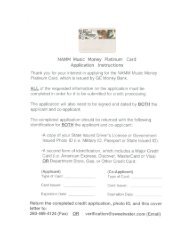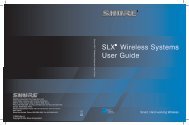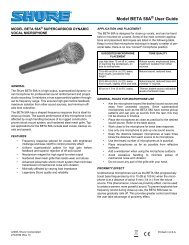Create successful ePaper yourself
Turn your PDF publications into a flip-book with our unique Google optimized e-Paper software.
Effects List<br />
30: 3D FLANGER<br />
This applies a 3D effect to the flanger sound. The flanger sound will<br />
be positioned 90 degrees left and 90 degrees right.<br />
fig.MFX-30<br />
L<br />
R<br />
Parameter Value Description<br />
Filter Type<br />
This applies a 3D effect to the step flanger sound. The flanger sound<br />
will be positioned 90 degrees left and 90 degrees right.<br />
fig.MFX-31<br />
OFF, LPF, HPF<br />
Type of filter<br />
OFF: no filter is used<br />
LPF: cuts the frequency range<br />
above the Cutoff Freq<br />
HPF: cuts the frequency range<br />
below the Cutoff Freq<br />
Cutoff Freq 200–8000 Hz Basic frequency of the filter<br />
Pre Delay<br />
0.0–100.0 ms<br />
Adjusts the delay time from when<br />
the direct sound begins until the<br />
flanger sound is heard.<br />
Rate 0.05–10.00 Hz, note Frequency of modulation<br />
Depth 0–127 Depth of modulation<br />
Phase 0–180 deg Spatial spread of the sound<br />
Feedback -98– +98%<br />
Output Mode<br />
SPEAKER, PHONES<br />
Adjusts the proportion of the<br />
flanger sound that is fed back into<br />
the effect. Negative (-) settings will<br />
invert the phase.<br />
Adjusts the method that will be<br />
used to hear the sound that is output<br />
to the OUTPUT jacks. The optimal<br />
3D effect will be achieved if<br />
you select SPEAKER when using<br />
speakers, or PHONES when using<br />
headphones.<br />
Low Gain -15– +15 dB Gain of the low range<br />
High Gain -15– +15 dB Gain of the high range<br />
Balance<br />
D100:0W–D0:100W<br />
Level 0–127 Output Level<br />
31: 3D STEP FLANGER<br />
L<br />
R<br />
Parameter Value Description<br />
Filter Type<br />
OFF, LPF, HPF<br />
Volume balance between the direct<br />
sound (D) and the flanger<br />
sound (W)<br />
Type of filter<br />
OFF: no filter is used<br />
LPF: cuts the frequency range<br />
above the Cutoff Freq<br />
HPF: cuts the frequency range<br />
below the Cutoff Freq<br />
Cutoff Freq 200–8000 Hz Basic frequency of the filter<br />
Pre Delay<br />
3D Flanger<br />
3D Step Flanger<br />
0.0–100.0 ms<br />
2-Band<br />
EQ<br />
2-Band<br />
EQ<br />
2-Band<br />
EQ<br />
2-Band<br />
EQ<br />
Adjusts the delay time from when<br />
the direct sound begins until the<br />
flanger sound is heard.<br />
Rate 0.05–10.00 Hz, note Frequency of modulation<br />
Depth 0–127 Depth of modulation<br />
L out<br />
R out<br />
L out<br />
R out<br />
Phase 0–180 deg Spatial spread of the sound<br />
Parameter Value Description<br />
Feedback -98– +98%<br />
A chorus effect that lets you apply an effect independently to the lowfrequency<br />
and high-frequency ranges.<br />
fig.MFX-32<br />
Adjusts the proportion of the<br />
flanger sound that is fed back into<br />
the effect. Negative (-) settings will<br />
invert the phase.<br />
Step Rate 0.10–20.00 Hz, note Rate (period) of pitch change<br />
Output Mode<br />
SPEAKER, PHONES<br />
Adjusts the method that will be<br />
used to hear the sound that is output<br />
to the OUTPUT jacks. The optimal<br />
3D effect will be achieved if<br />
you select SPEAKER when using<br />
speakers, or PHONES when using<br />
headphones.<br />
Low Gain -15– +15 dB Gain of the low range<br />
High Gain -15– +15 dB Gain of the high range<br />
Balance<br />
D100:0W–D0:100W<br />
Level 0–127 Output Level<br />
32: 2BAND CHORUS<br />
L in<br />
R in<br />
Parameter Range Explanation<br />
Split Freq<br />
Low Pre Delay<br />
Low Rate<br />
Low Depth 0–127<br />
Low Phase<br />
High Pre Delay<br />
High Rate<br />
200–8000 Hz<br />
0.0–100.0 ms<br />
0.05–10.00 Hz, note<br />
0–180 deg<br />
High Depth 0–127<br />
High Phase<br />
Split<br />
Split<br />
0.0–100.0 ms<br />
0.05–10.00 Hz, note<br />
0–180 deg<br />
Balance D100:0W–D0:100W<br />
High Band Chorus<br />
Low Band Chorus<br />
High Band Chorus<br />
Low Band Chorus<br />
Volume balance between the direct<br />
sound (D) and the flanger<br />
sound (W)<br />
Frequency at which the low and<br />
high ranges will be divided<br />
Delay time from when the original<br />
sound is heard to when the<br />
low-range chorus sound is heard<br />
Rate at which the low-range chorus<br />
sound is modulated<br />
Modulation depth for the lowrange<br />
chorus sound<br />
Level 0–127 Output volume<br />
L out<br />
R out<br />
Spaciousness of the low-range<br />
chorus sound<br />
Delay time from when the original<br />
sound is heard to when the<br />
high-range chorus sound is<br />
heard<br />
Rate at which the low-range chorus<br />
sound is modulated<br />
Modulation depth for the highrange<br />
chorus sound<br />
Spaciousness of the high-range<br />
chorus sound<br />
Volume balance of the original<br />
sound (D) and chorus sound (W)<br />
67
















